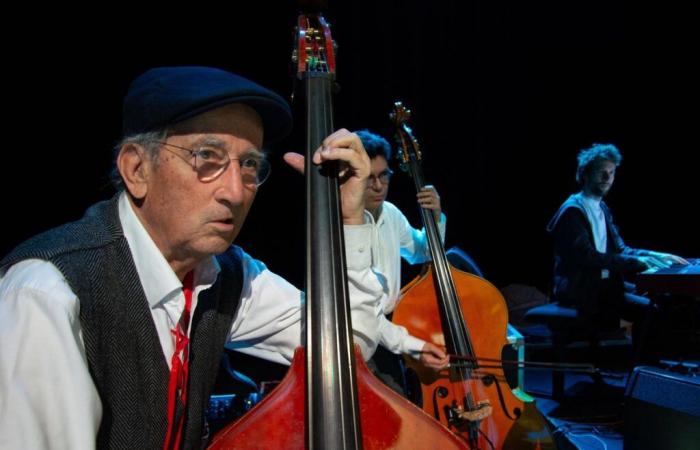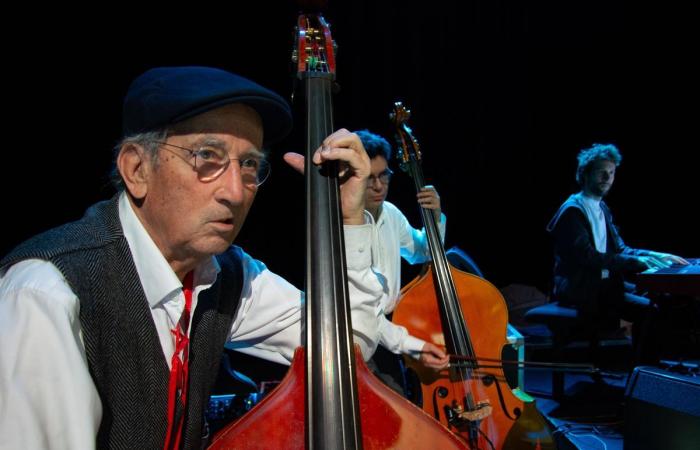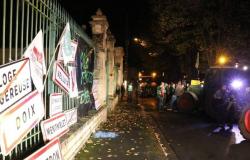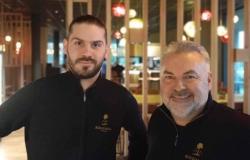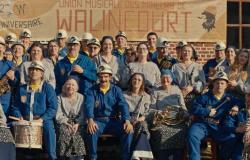Geneva artist –
In the four corners of the Junction with Sandro Rossetti
The creative Sandro Rossetti takes us to the Junction. This district bears witness to its impact on Geneva’s cultural life.
Published today at 3:31 p.m.
Sandro Rossetti, Geneva artist, celebrates his 80th birthday by playing the double bass.
dr
Subscribe now and enjoy the audio playback feature.
BotTalk
- Sandro Rossetti participated in saving several Geneva cultural places.
- He was born to an Italian family living in Geneva since 1922.
- He contributed to the rebirth of the Alhambra in 1977.
- Sandro had a profound impact on the Junction district.
“It is not necessarily by going around the world that we reach the universal, but as Ramuz said, by digging deep into the place where we live every day,” Sandro Rossetti told me straight away, polymorphous artist and architect. He was born in Junction and recently celebrated his 80the birthday by playing the double bass on the stage of the Alhambra, a hall that he helped to revive in 1977. He guides me today in the Junction districtwhere he left so much of his mark. In future articles, we will walk through other neighborhoods where he designed and created, always in good and cheerful company, cultural places that make Geneva so charming.
Originally from Piedmont
Sandro was born on rue des Rois, into an Italian immigrant family, originally from Piedmont and established in Geneva since 1922. His father was a bank employee, his stay-at-home mother took care of the three children and happily sang great arias. opera and introduced his eldest son to music, taking him to the Grand Theater and the Victoria Hall. The first part of Sandro’s childhood was happy, he loved his neighborhood, he sneaked out to play in the cemetery of the Kings, which was forbidden at the time, and, like a good little altar boy, served mass in a former coal shed, while waiting for the new church of Sainte-Clotilde which the Italians of the neighborhood then helped to build. It will be ready in 1965, the first parish to use the language of the people and where the priest addresses the assembly and not the altar!
But at 7 years old, the little boy full of life suffered from a serious illness of the time: tuberculosis! He must go alone to a sanatorium in Leysin, far from his family and his friends, and will stay there for five years. The disease affects the bone of one leg and will leave it limping. Sandro does not dwell on this traumatic period, but rather on the terrible appetite for life of his adolescence which followed his recovery. Despite a turbulent schooling, he moved towards studies and entered the School of Architecture, while developing drawing and musical practice. He joyfully mixes urban projects, drawing, theater and music, in the stimulating atmosphere of the years 68-78. He stays in Jonction, his beloved neighborhood, and occupies tiny apartments on rue des Bains and rue de la Jonction. It was only at the age of 65, and for love, that he left the Jonction district for rue Voltaire.
Save the Grand Théâtre warehouse
While strolling through the Junction, he shows me the building on avenue David-Dufour where he worked in the Cantonal Urban Planning Service for thirty-five years, always part-time, in order to better reconcile all his passions , and next to the church, the original warehouse of the Grand Théâtre, which he helped to save. He tells me about two theaters on the banks of the Arve, the Loup and the Parfumerie, two stages for which he worked ardently, and also about the Fanfare du Loup, in which he has played since 1978.
He points out to me the hill of La Bâtie which dominates the confluence of the two rivers. “It was in 1977 that the so-called marginal artists who had set up a festival at the Cité universitaire found the ideal location, in the Bois de la Bâtie. I was obviously in on the action, voluntarily building podiums, stands and shelters to protect us from the rain. André Chavanne, president of Public Education, trusted us and granted us a grant of 10,000 francs.” Entrance to the festival was free then.
We finish this first walk on the banks of the Rhône, at the end of the Halles de l’Île, which the architecture students of its class of 1971 saved with their demonstrations. The recent Bongo Joe record bistro, with its jazz concerts, reflects the tastes of the free, joyful and creative era of the 1960s.
Maryelle Budry is a neighborhood reporter for Signé Genève. Journalist for various magazines such as Jeunesse or Construire, Maryelle was also a psychologist for 30 years at the Career Guidance Service. She is now retired.More info
Did you find an error? Please report it to us.
0 comments

